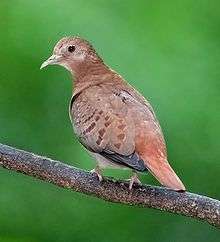Blue ground dove
| Blue ground dove | |
|---|---|
 | |
| male | |
| Scientific classification | |
| Kingdom: | Animalia |
| Phylum: | Chordata |
| Class: | Aves |
| Order: | Columbiformes |
| Family: | Columbidae |
| Genus: | Claravis |
| Species: | C. pretiosa |
| Binomial name | |
| Claravis pretiosa (Ferrari-Perez, 1886) | |
The blue ground dove (Claravis pretiosa) is a small New World tropical dove. It is a resident breeder from southeastern Mexico to northwestern Peru and northern Argentina, and on Trinidad.
The blue ground dove is relatively common in open woodland, forest edges, clearings and roadsides, especially in more humid areas. It is found from sea level to about 1200 m altitude. It builds a flimsy dish nest of twigs 1–11 m high in a tree and lays two white eggs.

blue ground doves are small pigeons, 20 cm long with a weight of 65-72 g . Adult males have blue-grey upperparts and paler grey underparts, becoming grey-white on the face. The flight feathers and outer tail feathers are blackish, and the wings are boldly spotted black (these spots often forming distinct bands). The iris is red or yellow, the bare eyering is green, and the legs are flesh-pink. The female has a grey-brown head neck and breast, becoming pale blue-grey on the underwings and belly. The back is ruddy brown, contrasting with the chestnut rump and tail. The spots in the wings are chestnut-brown. Young birds resemble the female, but have ruddy scaling on the back.
In most of its range, the male is unlikely to be confused with other species, but can locally be confused with the other members of the genus Claravis. The female also resembles the females of the other members of the genus Claravis, but at most localities it is more likely to be confused with the female ruddy ground dove, which is smaller and has blackish (not chestnut-brown) markings on the wings. In most regions where the blue ground dove occurs, a blue grey and a brown bird flying through the trees together is bound to be this species.
Blue ground doves occur singly, in pairs or sometimes in small groups. They feed mainly on the ground on seeds and small insects, and take grit. The male’s song, given from the treetops, is a loud boop.
References
- ↑ BirdLife International (2012). "Claravis pretiosa". IUCN Red List of Threatened Species. Version 2013.2. International Union for Conservation of Nature. Retrieved 26 November 2013.
- ffrench, Richard (1991). A Guide to the Birds of Trinidad and Tobago (2nd ed.). Comstock Publishing. ISBN 0-8014-9792-2.
- Hilty, Steven L (2003). Birds of Venezuela. London: Christopher Helm. ISBN 0-7136-6418-5.
- Stiles and Skutch, A guide to the birds of Costa Rica ISBN 0-8014-9600-4
